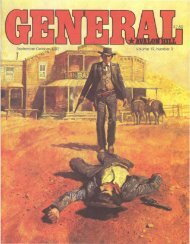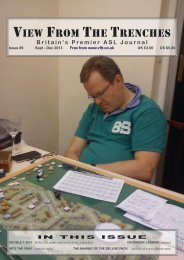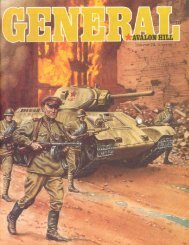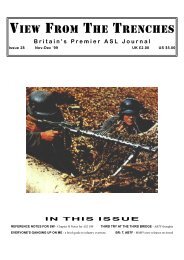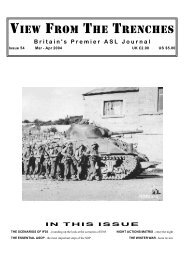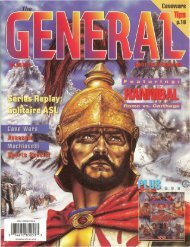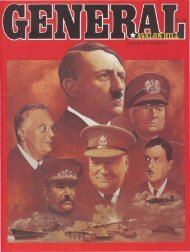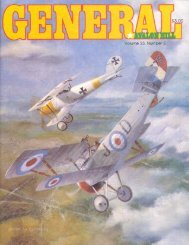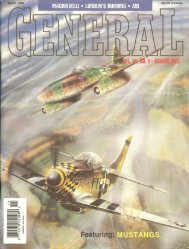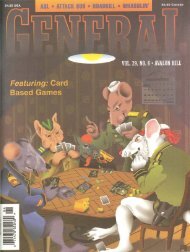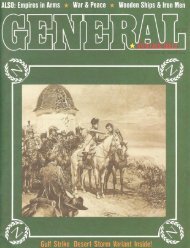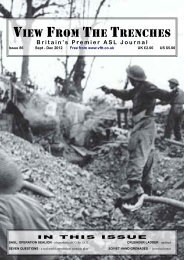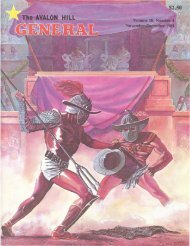Create successful ePaper yourself
Turn your PDF publications into a flip-book with our unique Google optimized e-Paper software.
22<br />
<strong>The</strong> player rolls on the Range Table to determine<br />
the range to target.<br />
<strong>The</strong> player then rolls on the Hit Table under the<br />
proper terrain ,;ategory to determine whether he indeed<br />
kills the animal. He rolls one die, and cross<br />
references the roll with the range determined from<br />
the Range Table. If the roll is less than the range of<br />
numbers indicated on the Hit Table, the animal is<br />
successfully killed, and the player scores points for<br />
it. Exception: If the player rolls exactly the number<br />
needed for a kill (for example, a roll of "3" in the<br />
300 ft. woods/mtn.lswamp category), then the<br />
animal is not killed outright, but is merely<br />
wounded. <strong>The</strong> player must "find" the animal by<br />
rolling on the Find Table under the proper terrain<br />
category. If the player rolls within the range indicated,<br />
he "finds" the animal and scores points<br />
for it. If he does not, then the animal is "lost". A<br />
spare counter is placed inverted over the symbol on<br />
the board, and no player may score points for that<br />
animal for the remainder of the game.<br />
Whenever points are scored for an animal, a<br />
spare counter is placed inverted over its symbol. No<br />
player may score points for that animal for the remainder<br />
of the game.<br />
If the animal is not killed in any given turn, the<br />
player may spend subsequent turns trying to do so,<br />
by beginning once again with the Track Table. A<br />
player may also refrain from shooting after he rolls<br />
on the Range Table, and may likewise begin again<br />
with the Track Table on his next turn.<br />
7. Turn Limit: Play proceeds for 25 turns. If a<br />
player is reduced below life level "0" before the end<br />
of 25 turns, he is removed from play.<br />
Variations:<br />
A. Reverse the initial set up locations of players<br />
and herds.<br />
B. Use the Wilderness Encounter Chart on the<br />
back of the Scenario 4-Rescue card.<br />
C. Players may change the turn limit for a longer or<br />
shorter game, as desired.<br />
Concluding Remarks<br />
<strong>The</strong> players will find themselves making various<br />
decisions, not the least of which is, "Which way<br />
should I go?" Apart from that, the player must<br />
decide whether he is going to risk going after one of<br />
the elusive herds, or try to track one of the animals<br />
which at least stays within its own hex-defined territory.<br />
If he finds himself at a long range from his<br />
target, he must decide whether to shoot and risk<br />
wounding (and possibly losing) the animal, or<br />
whether to track the animal to a possible closer<br />
range next turn. He must decide when to head for a<br />
base for rest and replenishment, and when to risk<br />
starvation to go after "one more animal". <strong>The</strong><br />
game can become quite suspenseful when a player<br />
finds himself barely crawling into a base camp. All<br />
in all, players should find themselves challenged by<br />
the dual goals of hunting wild animals, and simply<br />
staying alive.<br />
*****<br />
DESIGN ANALYSIS .... Continued from Page 44<br />
handed, but it does work, and it would not be easy<br />
to replace with something more sophisticated.<br />
In the DIADEM scenario, the Germans can be<br />
forced into an awkward defensive stance,<br />
something that isn't possible in the campaign game,<br />
because it's impossible to predict where the front<br />
line will be when the strikes occur. It also might be<br />
possible to dilute and spread out the so-called air<br />
strike, perhaps making it a one-column boo t,<br />
andlor restricting the number of attacks, preceded<br />
by two months ofAllied interdiction. Such a change<br />
is appealing, but it has one big drawback: the<br />
79-turn campaign game of A NZIO, which takes 24<br />
hours to play, does work, and has since 1969. This is<br />
no small feat, as disappointed buyers ofsome other<br />
die<br />
roll<br />
1<br />
2<br />
3<br />
4<br />
5<br />
6<br />
marathon games have discovered. Tinkering with<br />
the key airstrike rule would require a herculean<br />
playtesting effort to make sure the existing delicate<br />
balance of the game would not be destroyed. <strong>The</strong><br />
difficulty of improving on this unsophisticated rule<br />
has been underlined for me by the fact that over the<br />
years I have been inundated with minor variant suggestions<br />
for ANZIO, many of them excellent, but<br />
no one yet has tackled the airstrike.<br />
Evolution of the ANZIO SRT (step reduction table)<br />
<strong>The</strong> 1969 version of A NZIO had three combat<br />
resolution tables. Two applied to the 1969 Basic<br />
Game, and were based on elimination of units.<br />
<strong>The</strong>se were deleted from the 1974 revision, and<br />
therefore the 1978 edition as well.<br />
<strong>The</strong> remaining 1969 table, based on step losses,<br />
had ten odds columns, ranging from 1-4 to 9-1.<br />
Grouped together in one odds column were 1-4 and<br />
1-3 attacks, and in another column, 6-1 and 7-1 attacks.<br />
<strong>The</strong> reason for this isn't clear, as the progression<br />
of combat results permitted these odds columns<br />
to be separated. <strong>The</strong> SRT supplied with the<br />
1974 and 1978 editions has twelve columns, as 1-4<br />
and 1-3,6-1 and 7-1, are separated.<br />
Losses in Italy sometimes ran high, particularly<br />
in repeated attacks against the many strong defensive<br />
positions. <strong>The</strong> ANZIOSRT renects this well, at<br />
times, almost 100 well. Apart from the simple task<br />
of separating the odds columns, as explained<br />
above, the 1974-78 SRT is unchanged from 1969,<br />
and retains the disastrous result for a die roll of '6'<br />
in a 2-1 attack. Most of the attacking in ANZIO is<br />
done by the Allies, and a 2-1 is probably the second<br />
most frequent attack, with only I-I odds being<br />
more frequent. A '6' in a 2-1 attack results in a loss<br />
of one step to the defender, and Ihree to the attacker.<br />
Of the seventy-two results possible in the<br />
1974-78 SRT, only this one results in the loss of<br />
three steps to the attacker. Since most ANZIO attacks<br />
are against doubled or tripled positions (hence<br />
doubled losses), the attacker's loss in a 2-1, die roll<br />
six, would often be not just three, but six steps.<br />
Three steps is equivalent to the complete destruction<br />
of many of the Allied divisions in the game.<br />
Sometimes it is difficult for the Allied player to arrange<br />
his attack to avoid losing one or more units in<br />
a 2-1, if the result is a six.<br />
Figure 2<br />
No retreat<br />
-.. Defender always retreats.<br />
slandard<br />
112R<br />
O/IR<br />
III<br />
OlD<br />
R2/1<br />
R3/1<br />
optional<br />
OI2R<br />
l/IR<br />
III<br />
III<br />
R2/1<br />
R2/0<br />
<strong>The</strong> range of loss to the attacker is reduced from<br />
0-3 to 0-2. In order to do that, the number of die<br />
rolls at which the attacker suffers some loss is increased<br />
from four to five. <strong>The</strong> defenders results are<br />
not changed, just rearranged in order to make a<br />
more orderly progression from die roll one to die<br />
roll six. In the optional SRT, the results are rearranged<br />
not only to smooth out the extremes, but 10<br />
make the progression from die roll one to die roll six<br />
increasingly worse for the attacker, and better for<br />
the defender. This same tendency is present in the<br />
standard SRT as well, but with certain discrepancies.<br />
In my opinion, the revised SRT used in this<br />
issue's Series Replay is more logical than the standard<br />
SRT, and discarding the extreme three step<br />
loss improves the game. Allied losses are heavy<br />
enough without this disaster looming over them.<br />
6><br />
SRT Losses odds<br />
1-4 1-3 1-2 I-I 2-1 3-1 4-1 5-1 6-1 7-1 8-1 9-1<br />
standard allacker 4 5 5 7 7 5 5 '5 5 5 5 5<br />
defender I I 2 5 6 8 12 16 22 27 31 37<br />
optional allacker 4 '5 5 7 5 5 5 5 5 5 5<br />
defender 1 1 2 5 6 8 12 16 22 27 30 36<br />
DR<br />
1<br />
2<br />
3<br />
4<br />
5<br />
6<br />
die<br />
roll<br />
For the past several years, 1have made available<br />
about once a year an addendum to ANZIO, including<br />
a revised SRT. This was the SRTused in this<br />
issue's DIADEM four-player Series Replay and is<br />
reproduced here in Figure 1.<br />
This SRT is basically quite similar to that sold<br />
with the game, but with the more extreme results<br />
smoothed out. <strong>The</strong> incidence of retreats is unchanged.<br />
<strong>The</strong> average step loss is also very little<br />
different. Suppose a series of seventy-two attacks<br />
including one die roll (one through six) for each of<br />
the twelve odds columns. <strong>The</strong> total losses that<br />
would result for each SRT is shown in Figure 2.<br />
Note that the ONLY difference is that in the optional<br />
SRT, at 8-1 and 9-1 odds, the defender loses<br />
one step less in each case. <strong>The</strong> only reason for this<br />
change, of negligible significance in the game, is to<br />
"smooth out" the progression of losses. This<br />
"smoothing out" process can be illustrated by comparing<br />
one odds column, 2-1 in this case:<br />
2<br />
3<br />
4<br />
5<br />
6



